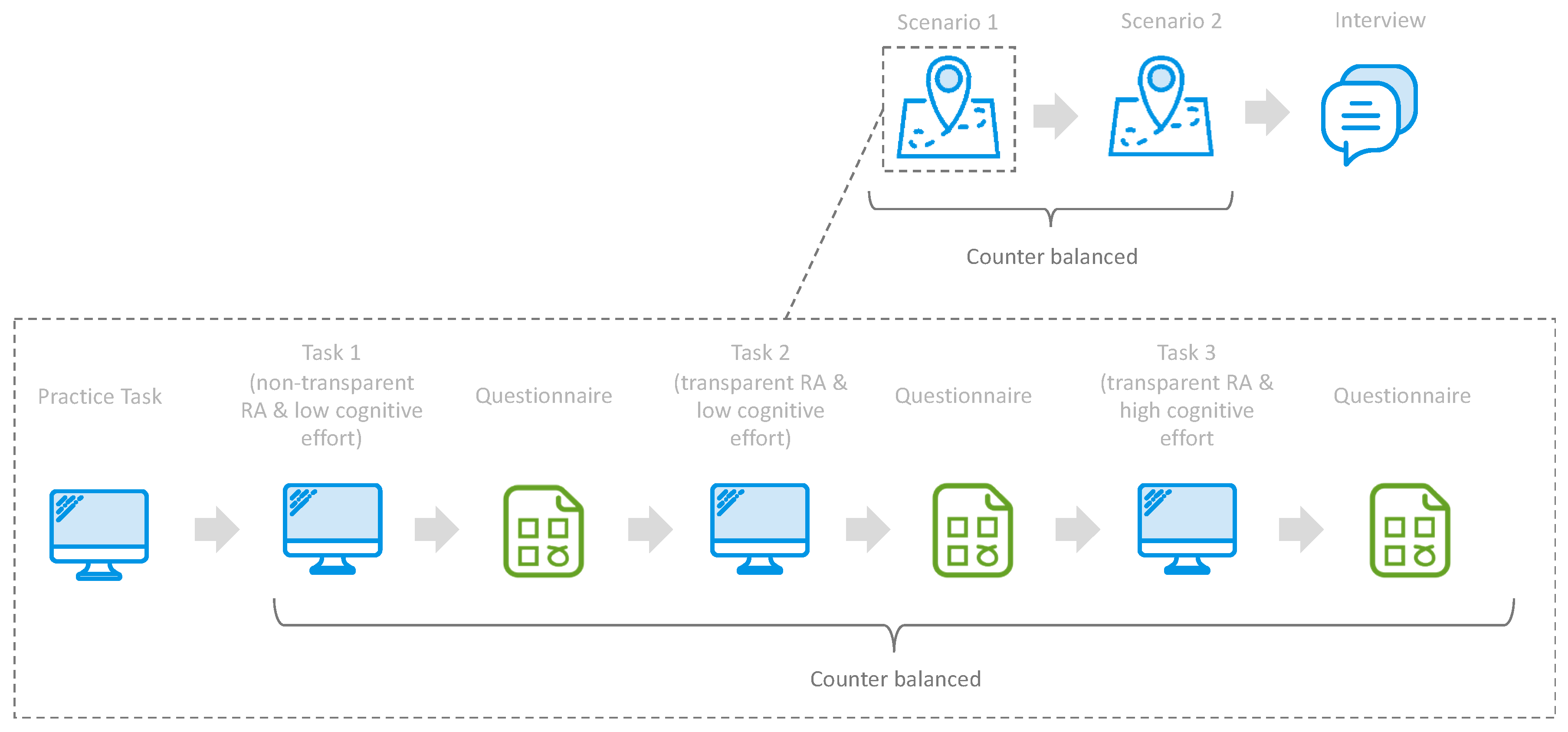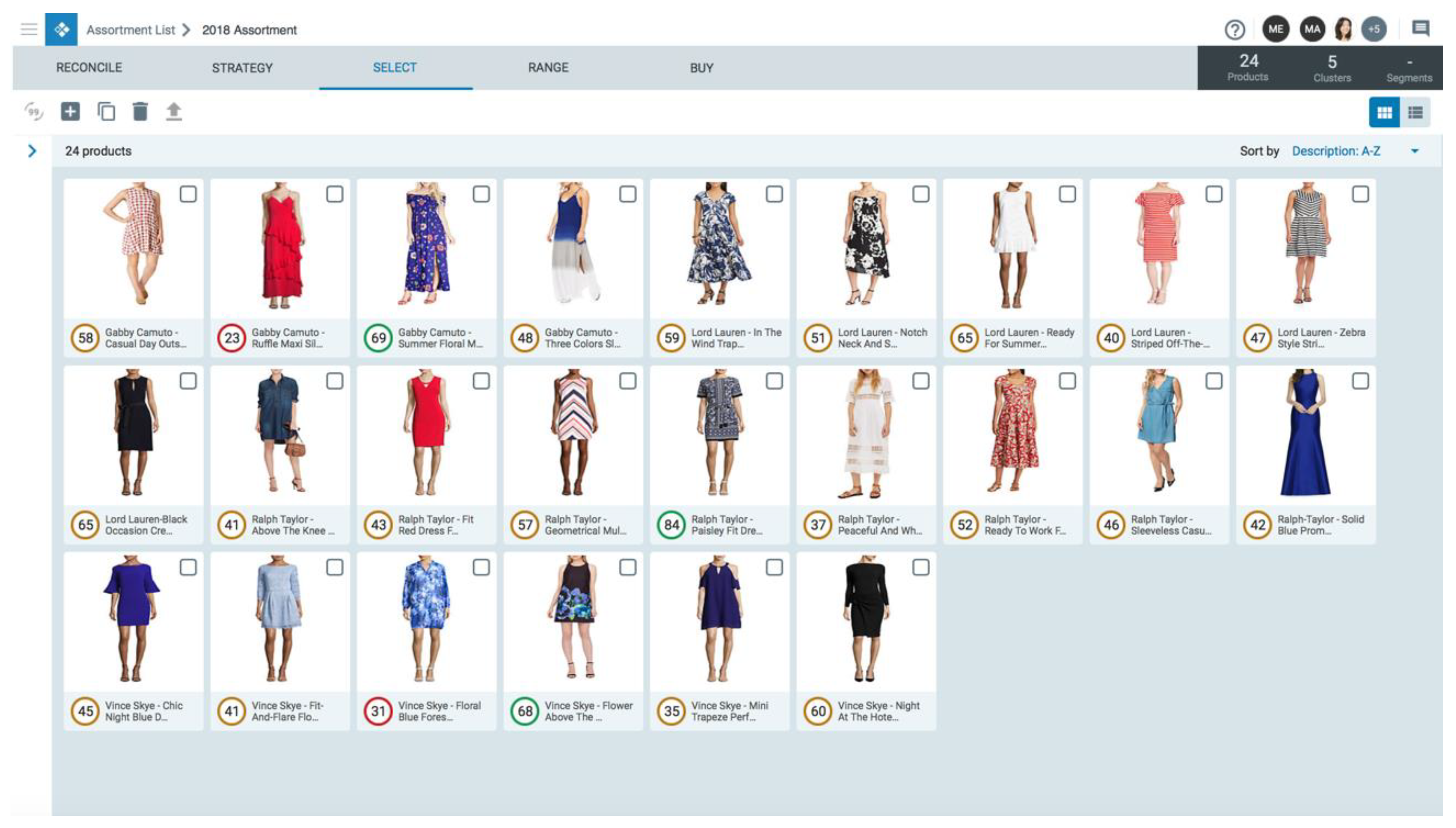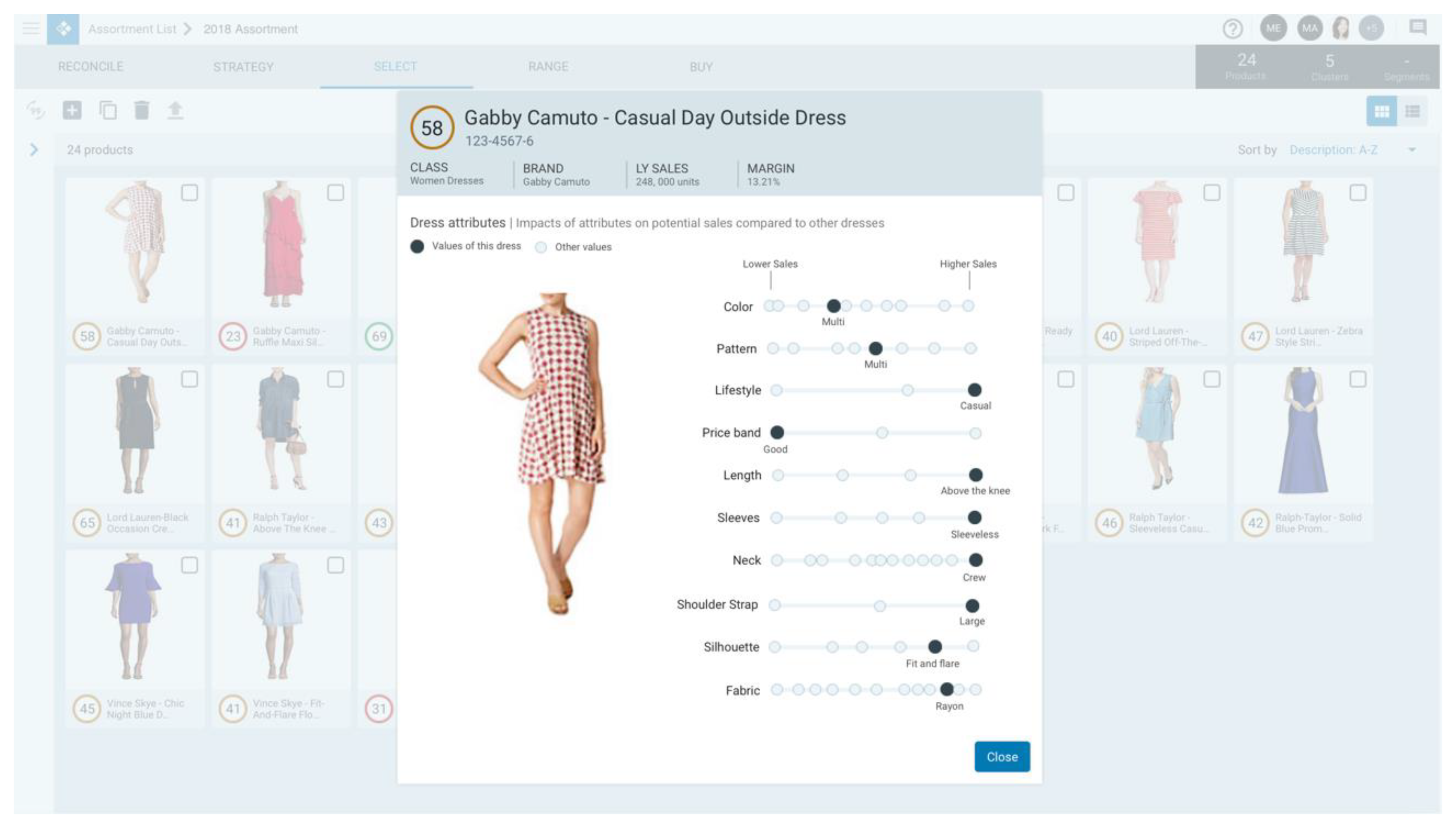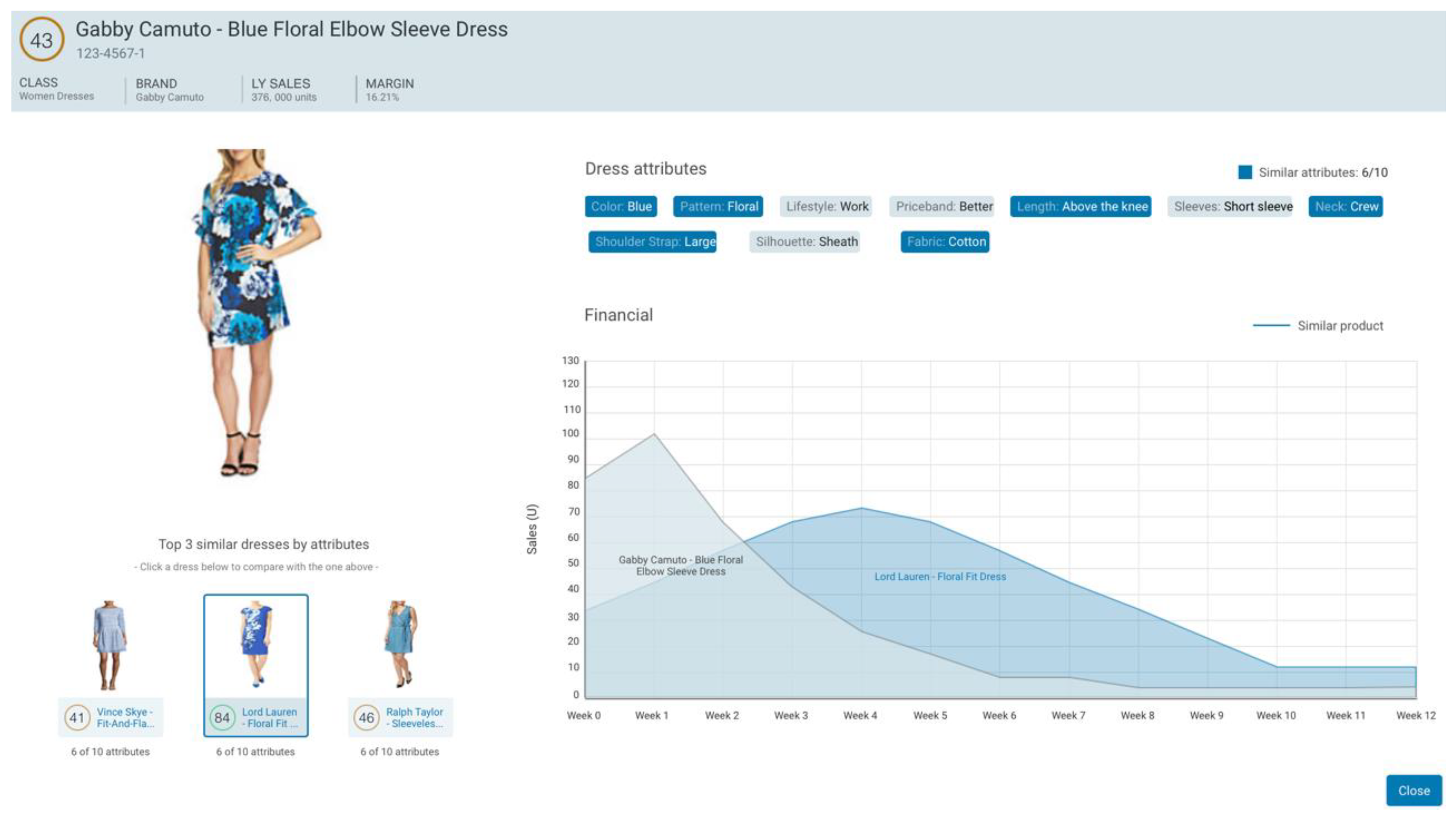Recommendation Agent Adoption: How Recommendation Presentation Influences Employees’ Perceptions, Behaviors, and Decision Quality
Abstract
:Featured Application
Abstract
1. Introduction
2. Background
2.1. RA Transparency
2.2. Cognitive Effort and RA Transparency
2.3. Impact of Transparency and Cognitive Effort on Users’ Perceptions, Usage Behavior, and Decision Quality
3. Hypotheses
4. Methodology
4.1. Experimental Setting
4.2. Measures
5. Results
6. Discussion
7. Conclusions
Author Contributions
Funding
Conflicts of Interest
References
- Mantrala, M.K. Why is assortment planning so difficult for retailers? A framework and research agenda. J. Retail. 2009, 85, 71–83. [Google Scholar] [CrossRef]
- Amine, A.; Cadenat, S. Efficient retailer assortment: A consumer choice evaluation perspective. Int. J. Retail. Distrib. Manag. 2003, 31, 486–497. [Google Scholar] [CrossRef]
- Handelsman, M.; Munson, J.M. On integrating consumer needs for variety with retailer assortment decisions. ACR North. Am. Adv. 1985, 12, 108–112. [Google Scholar]
- Brijs, T. Using association rules for product assortment decisions: A case study. In KDD; Citeseer: Diepenbeek, Belgium, 1999. [Google Scholar]
- Lurie, N.H. Decision making in information-rich environments: The role of information structure. J. Consum. Res. 2004, 30, 473–486. [Google Scholar] [CrossRef]
- Andrews, W. Predicts 2018: Artificial Intelligence; Gartner: Stanford, CT, USA, 2017; p. 343423. [Google Scholar]
- Senecal, S.; Nantel, J. The influence of online product recommendations on consumers’ online choices. J. Retail. 2004, 80, 159–169. [Google Scholar] [CrossRef]
- Wang, W.; Benbasat, I. Recommendation agents for electronic commerce: Effects of explanation facilities on trusting beliefs. J. Manag. Inf. Syst. 2007, 23, 217–246. [Google Scholar] [CrossRef]
- Gregor, S.; Benbasat, I. Explanations from intelligent systems: Theoretical foundations and implications for practice. MIS Q. 1999, 23, 497–530. [Google Scholar] [CrossRef]
- De Greef, H.; Neerincx, M.A. Cognitive support: Designing aiding to supplement human knowledge. Int. J. Hum. Comput. Stud. 1995, 42, 531–571. [Google Scholar] [CrossRef]
- Gregor, S. Explanations from knowledge-based systems and cooperative problem solving: An empirical study. Int. J. Hum. Comput. Stud. 2001, 54, 81–105. [Google Scholar] [CrossRef]
- Heitmann, M.; Lehmann, D.R.; Herrmann, A. Choice goal attainment and decision and consumption satisfaction. J. Mark. Res. 2007, 44, 234–250. [Google Scholar] [CrossRef]
- Zanker, M. The influence of knowledgeable explanations on users’ perception of a recommender system. In Proceedings of the Sixth ACM Conference on Recommender Systems, Dublin, Ireland, 9–13 September 2012. [Google Scholar]
- Gedikli, F.; Jannach, D.; Ge, M. How should I explain? A comparison of different explanation types for recommender systems. Int. J. Hum. Comput. Stud. 2014, 72, 367–382. [Google Scholar]
- Vig, J.; Sen, S.; Riedl, J. Tagsplanations: Explaining recommendations using tags. In Proceedings of the 14th International Conference on Intelligent User Interfaces, Sanibel Island, FL, USA, 8–11 February 2009; pp. 47–56. [Google Scholar]
- Pu, P.; Chen, L. Trust building with explanation interfaces. In Proceedings of the 11th International Conference on Intelligent User Interfaces, Sydney, Australia, 29 January–1 February 2006; pp. 93–100. [Google Scholar]
- Eppler, M.J.; Mengis, J. The concept of information overload: A review of literature from organization science, accounting, marketing, MIS, and related disciplines. Inf. Soc. 2004, 20, 325–344. [Google Scholar] [CrossRef]
- Bechwati, N.N.; Xia, L. Do computers sweat? The impact of perceived effort of online decision aids on consumers’ satisfaction with the decision process. J. Consum. Psychol. 2003, 13, 139–148. [Google Scholar]
- Fogg, B.J. How do users evaluate the credibility of Web sites?: A study with over 2,500 participants. In Proceedings of the 2003 Conference on Designing for User Experiences, San Francisco, CA, USA, 6–7 June 2003. [Google Scholar]
- Ohanian, R. Construction and validation of a scale to measure celebrity endorsers’ perceived expertise, trustworthiness, and attractiveness. J. Advert. 1990, 19, 39–52. [Google Scholar] [CrossRef]
- Hyan Yoo, K.; Gretzel, U. The influence of perceived credibility on preferences for recommender systems as sources of advice. Inf. Technol. Tour. 2008, 10, 133–146. [Google Scholar] [CrossRef]
- Yoo, K.-H.; Gretzel, U. Creating more credible and persuasive recommender systems: The influence of source characteristics on recommender system evaluations. In Recommender Systems Handbook; Springer: Boston, MA, USA, 2011; pp. 455–477. [Google Scholar]
- Xiao, B.; Benbasat, I. E-commerce product recommendation agents: Use, characteristics, and impact. MIS Q. 2007, 31, 137–209. [Google Scholar] [CrossRef]
- Sinha, R.; Swearingen, K. The role of transparency in recommender systems. In Proceedings of the CHI’02 Extended Abstracts on Human Factors in Computing Systems, Minneapolis, MN, USA, 20–25 April 2002. [Google Scholar]
- Herlocker, J.L.; Konstan, J.A.; Riedl, J. Explaining collaborative filtering recommendations. In Proceedings of the 2000 ACM Conference on Computer Supported Cooperative Work, Philadelphia, PA, USA, 2–6 December 2000; pp. 241–250. [Google Scholar]
- Swearingen, K.; Sinha, R. Beyond algorithms: An HCI perspective on recommender systems. In ACM SIGIR 2001 Workshop on Recommender Systems; Citeseer: Berkeley, CA, USA, 2001; Volume 13, pp. 1–11. [Google Scholar]
- Konstan, J.A.; Riedl, J. Recommender systems: From algorithms to user experience. User Model. User Adapt. Interact. 2012, 22, 101–123. [Google Scholar] [CrossRef]
- Payne, J.W. The Adaptive Decision Maker; Cambridge University Press: Cambridge, UK, 1993. [Google Scholar]
- Beach, L.R. Broadening the definition of decision making: The role of prechoice screening of options. Psychol. Sci. 1993, 4, 215–220. [Google Scholar] [CrossRef]
- Johnson, E.J.; Payne, J.W. Effort and accuracy in choice. Manag. Sci. 1985, 31, 395–414. [Google Scholar] [CrossRef]
- Payne, J.W. Contingent decision behavior. Psychol. Bull. 1982, 92, 382. [Google Scholar] [CrossRef]
- Häubl, G.; Trifts, V. Consumer decision making in online shopping environments: The effects of interactive decision aids. Mark. Sci. 2000, 19, 4–21. [Google Scholar] [CrossRef]
- Dellaert, B.G.; Häubl, G. Searching in choice mode: Consumer decision processes in product search with recommendations. J. Mark. Res. 2012, 49, 277–288. [Google Scholar] [CrossRef]
- Huseynov, F.; Huseynov, S.Y.; Özkan, S. The influence of knowledge-based e-commerce product recommender agents on online consumer decision-making. Inf. Dev. 2016, 32, 81–90. [Google Scholar] [CrossRef]
- Pereira, R.E. Influence of query-based decision aids on consumer decision making in electronic commerce. Inf. Resour. Manag. J. 2001, 14, 31–48. [Google Scholar] [CrossRef]
- Hoch, S.J.; Schkade, D.A. A psychological approach to decision support systems. Manag. Sci. 1996, 42, 51–64. [Google Scholar] [CrossRef]
- Kim, D.J.; Ferrin, D.L.; Rao, H.R. Trust and satisfaction, two stepping stones for successful e-commerce relationships: A longitudinal exploration. Inf. Syst. Res. 2009, 20, 237–257. [Google Scholar] [CrossRef]
- Bharati, P.; Chaudhury, A. An empirical investigation of decision-making satisfaction in web-based decision support systems. Decis. Support. Syst. 2004, 37, 187–197. [Google Scholar] [CrossRef]
- Delone, W.H.; McLean, E.R. The DeLone and McLean model of information systems success: A ten-year update. J. Manag. Inf. Syst. 2003, 19, 9–30. [Google Scholar]
- Bailey, J.E.; Pearson, S.W. Development of a tool for measuring and analyzing computer user satisfaction. Manag. Sci. 1983, 29, 530–545. [Google Scholar] [CrossRef]
- Komiak, S.Y.; Benbasat, I. The effects of personalization and familiarity on trust and adoption of recommendation agents. MIS Q. 2006, 30, 941–960. [Google Scholar] [CrossRef]
- Hengstler, M.; Enkel, E.; Duelli, S. Applied artificial intelligence and trust—The case of autonomous vehicles and medical assistance devices. Technol. Forecast. Soc. Chang. 2016, 105, 105–120. [Google Scholar] [CrossRef]
- Swearingen, K.; Sinha, R. Interaction design for recommender systems. Des. Interact. Syst. 2002, 6, 312–334. [Google Scholar]
- Karahanna, E.; Straub, D.W.; Chervany, N.L. Information technology adoption across time: A cross-sectional comparison of pre-adoption and post-adoption beliefs. MIS Q. 1999, 23, 183–213. [Google Scholar] [CrossRef]
- Davis, F.D.; Bagozzi, R.P.; Warshaw, P.R. User acceptance of computer technology: A comparison of two theoretical models. Manag. Sci. 1989, 35, 982–1003. [Google Scholar] [CrossRef]
- Aljukhadar, M.; Senecal, S.; Daoust, C.-E. Using recommendation agents to cope with information overload. Int. J. Electron. Commer. 2012, 17, 41–70. [Google Scholar] [CrossRef]
- Chen, S.; Epps, J. Automatic classification of eye activity for cognitive load measurement with emotion interference. Comput. Methods Progr. Biomed. 2013, 110, 111–124. [Google Scholar] [CrossRef]
- Lai, M.-L. A review of using eye-tracking technology in exploring learning from 2000 to 2012. Educ. Res. Rev. 2013, 10, 90–115. [Google Scholar] [CrossRef]
- Bradley, M.M.; Lang, P.J. Measuring emotion: The self-assessment manikin and the semantic differential. J. Behav. Ther. Exp. Psychiatry 1994, 25, 49–59. [Google Scholar] [CrossRef]
- Sirdeshmukh, D.; Singh, J.; Sabol, B. Consumer trust, value, and loyalty in relational exchanges. J. Mark. 2002, 66, 15–37. [Google Scholar] [CrossRef]
- Léger, P.-M. Precision is in the eye of the beholder: Application of eye fixation-related potentials to information systems research. J. Assoc. for Inf. Syst. 2014, 15, 3. [Google Scholar] [CrossRef]
- Vayre, J.-S. Effet distracteur des agents de recommandation et stratégies de navigation des consommateurs. Revue d’Interaction Homme-Machine 2006, 7, 1–29. [Google Scholar]
- Wook Chae, S.; Chang Lee, K. Exploring the effect of the human brand on consumers’ decision quality in online shopping: An eye-tracking approach. Online Inf. Rev. 2013, 37, 83–100. [Google Scholar] [CrossRef]
- Just, M.A.; Carpenter, P.A. Eye fixations and cognitive processes. Cogn. Psychol. 1976, 8, 441–480. [Google Scholar] [CrossRef]
- Rayner, K. Eye movements in reading and information processing: 20 years of research. Psychol. Bull. 1998, 124, 372. [Google Scholar] [CrossRef] [PubMed]
- Nilsson, N.J. Principles of Artificial Intelligence; Morgan Kaufmann: Burlington, MA, USA, 2014. [Google Scholar]
- Riedl, R.; Léger, P.-M. Fundamentals of NeuroIS; Studies in Neuroscience, Psychology and Behavioral Economics; Springer: Berlin/Heidelberg, Germany, 2016. [Google Scholar]
- Leger, P.-M.; Riedl, R.; vom Brocke, J. Emotions and ERP information sourcing: The moderating role of expertise. Ind. Manag. Data Syst. 2014, 114, 456–471. [Google Scholar] [CrossRef]
- Courtemanche, F. Physiological heatmaps: A tool for visualizing users’ emotional reactions. Multimed. Tools Appl. 2018, 77, 11547–11574. [Google Scholar] [CrossRef]




| Hypothesis | Result | Estimate | p-Value | |
|---|---|---|---|---|
| Source credibility | H1a (T2 > T1 and T2 > T3) | T2 > T1 | 0.7055 | <0.0001 |
| T2 > T3 | 0.0916 | 0.2554 | ||
| Control | H1b (T2 > T1 and T2 > T3) | T2 > T1 | 0.3500 | 0.0185 |
| T2 > T3 | 0.3000 | 0.0365 | ||
| Decision quality | H1c (T2 > T1 and T2 > T3) | T2 > T1 | 0.4706 | 0.0474 |
| T2 > T3 | 0.2991 | 0.0678 | ||
| Satisfaction | H1d (T2 > T1 and T2 > T3) | T2 > T1 | 0.6068 | 0.0027 |
| T2 > T3 | 0.0964 | 0.3052 |
| Hypothesis | Result | Estimate | p-Value | |
|---|---|---|---|---|
| Decision quality | H2 (T2 > T1 and T2 > T3) | T2 > T1 | 1.0500 | 0.0001 |
| T2 > T3 | 0.2330 | 0.0001 |
| Hypothesis | Results | Estimate | p-Value | |
|---|---|---|---|---|
| Intention to adopt the RA as a decision Aid | H5 (T2 > T1 and T3 > T1) | T2 > T1 | 1.0705 | 0.0001 |
| T3 > T1 | 0.9681 | 0.0002 |
© 2019 by the authors. Licensee MDPI, Basel, Switzerland. This article is an open access article distributed under the terms and conditions of the Creative Commons Attribution (CC BY) license (http://creativecommons.org/licenses/by/4.0/).
Share and Cite
Bigras, É.; Léger, P.-M.; Sénécal, S. Recommendation Agent Adoption: How Recommendation Presentation Influences Employees’ Perceptions, Behaviors, and Decision Quality. Appl. Sci. 2019, 9, 4244. https://doi.org/10.3390/app9204244
Bigras É, Léger P-M, Sénécal S. Recommendation Agent Adoption: How Recommendation Presentation Influences Employees’ Perceptions, Behaviors, and Decision Quality. Applied Sciences. 2019; 9(20):4244. https://doi.org/10.3390/app9204244
Chicago/Turabian StyleBigras, Émilie, Pierre-Majorique Léger, and Sylvain Sénécal. 2019. "Recommendation Agent Adoption: How Recommendation Presentation Influences Employees’ Perceptions, Behaviors, and Decision Quality" Applied Sciences 9, no. 20: 4244. https://doi.org/10.3390/app9204244
APA StyleBigras, É., Léger, P.-M., & Sénécal, S. (2019). Recommendation Agent Adoption: How Recommendation Presentation Influences Employees’ Perceptions, Behaviors, and Decision Quality. Applied Sciences, 9(20), 4244. https://doi.org/10.3390/app9204244





